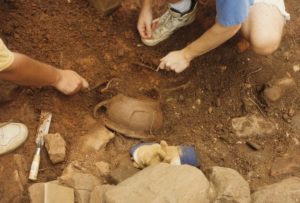Archaeology



The Department of Moravian Research & Archaeology oversees and investigates a variety of archaeological resources within the Old Salem National Historic Landmark District. Carefully designed and executed research aims to understand better how the town of Salem developed through time and its relationship to other Moravian communities located in the Wachovia tract and beyond. To this end, the department oversees: the evaluation of archaeological resources within the district; the preparation of archaeological research designs; the surveying, testing, and excavation of archaeological resources; and the processing and curation of recovered artifacts. Reports and articles prepared by the Department of Archaeology, as well as presentations to professionals and the broader public, increase awareness and understanding of the significance of Old Salem, the Wachovia tract, and the Moravian experience.
Previous Research
As part of a partnership with the North Carolina Digital Heritage Center, many of the archaeological reports from the department’s previous work will be digitized and made available to the public on the Old Salem Museums & Gardens website.
Current Projects
With the incorporation of the Department of Moravian Research & Archaeology into the Collections, Research & Archaeology Division in 2018, Old Salem Museums & Gardens is currently working on a 5-year strategic plan aimed at increasing community engagement and offering more opportunities for the public to participate in the department’s work. The Department is also currently engaged in the excavation and analysis of pottery kilns built and operated on Lot 38 from 1793 until 1831. Originally built under the supervision of Salem’s second master potter, Rudolph Christ, the kilns continued to operate during the tenure of his successor John F. Holland. The pottery fired in these kilns not only represents the work of these two potters, but it also reflects the labor of several apprentices, journeymen, and an enslaved potter, Peter Oliver. Ultimately, this research focuses on understanding the design of Moravian pottery kilns during this period, how the introduction of new techniques affected the organization of pottery production on the landscape, and how the social relations of pottery production changed over time.
Future Work
As part of the Hidden Town Project, the Department of Moravian Research & Archaeology is collaborating with the Department of Marine, Earth & Atmospheric Sciences at North Carolina State University to conduct a geophysical survey of select properties within the district. This survey will employ non-invasive methods, such as ground-penetrating radar, to help locate buried structures and features associated with Salem’s enslaved population. Results from this survey will help guide future archaeological research in support of the Hidden Town Project.




